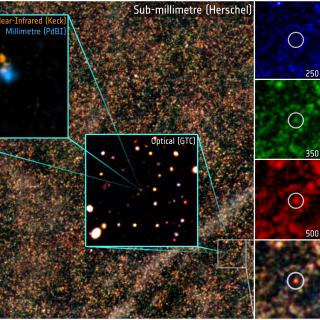Bibcode
Hardcastle, M. J.; Virdee, J. S.; Jarvis, M. J.; Bonfield, D. G.; Dunne, L.; Rawlings, S.; Stevens, J. A.; Christopher, N. M.; Heywood, I.; Mauch, T.; Rigopoulou, D.; Verma, A.; Baldry, I. K.; Bamford, S. P.; Buttiglione, S.; Cava, A.; Clements, D. L.; Cooray, A.; Croom, S. M.; Dariush, A.; de Zotti, G.; Eales, S.; Fritz, J.; Hill, D. T.; Hughes, D.; Hopwood, R.; Ibar, E.; Ivison, R. J.; Jones, D. H.; Loveday, J.; Maddox, S. J.; Michałowski, M. J.; Negrello, M.; Norberg, P.; Pohlen, M.; Prescott, M.; Rigby, E. E.; Robotham, A. S. G.; Rodighiero, G.; Scott, D.; Sharp, R.; Smith, D. J. B.; Temi, P.; van Kampen, E.
Referencia bibliográfica
Monthly Notices of the Royal Astronomical Society, Volume 409, Issue 1, pp. 122-131.
Fecha de publicación:
11
2010
Número de citas
24
Número de citas referidas
21
Descripción
We use the Herschel-Astrophysical Terahertz Large Area Survey (ATLAS)
science demonstration data to investigate the star formation properties
of radio-selected galaxies in the GAMA-9h field as a function of radio
luminosity and redshift. Radio selection at the lowest radio
luminosities, as expected, selects mostly starburst galaxies. At higher
radio luminosities, where the population is dominated by active galactic
nuclei (AGN), we find that some individual objects are associated with
high far-infrared luminosities. However, the far-infrared properties of
the radio-loud population are statistically indistinguishable from those
of a comparison population of radio-quiet galaxies matched in redshift
and K-band absolute magnitude. There is thus no evidence that the host
galaxies of these largely low-luminosity (Fanaroff-Riley class I), and
presumably low-excitation, AGN, as a population, have particularly
unusual star formation histories. Models in which the AGN activity in
higher luminosity, high-excitation radio galaxies is triggered by major
mergers would predict a luminosity-dependent effect that is not seen in
our data (which only span a limited range in radio luminosity) but which
may well be detectable with the full Herschel-ATLAS data set.
Herschel is an ESA space observatory with science instruments provided
by European-led Principal Investigator consortia and with important
participation from NASA.
E-mail: m.j.hardcastle [at] herts.ac.uk (m[dot]j[dot]hardcastle[at]herts[dot]ac[dot]uk)
Proyectos relacionados

Formación y Evolución de Galaxias: Observaciones Infrarrojas y en otras Longitudes de Onda
Este grupo desarrolla varios proyectos extragalácticos en diferentes rangos del espectro electromagnético utilizando satélites y telescopios en tierra para estudiar la evolución cosmológica de las galaxias y el origen de la actividad nuclear en galaxias activas. En el aspecto instrumental, el grupo forma parte del consorcio internacional que ha
Ismael
Pérez Fournon